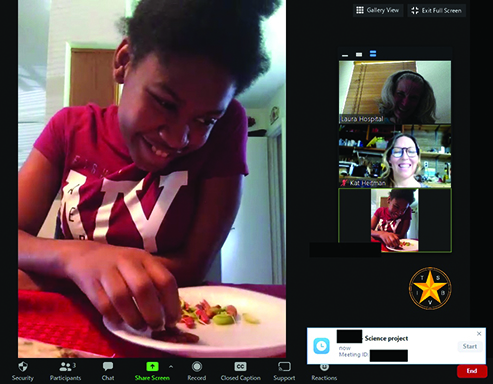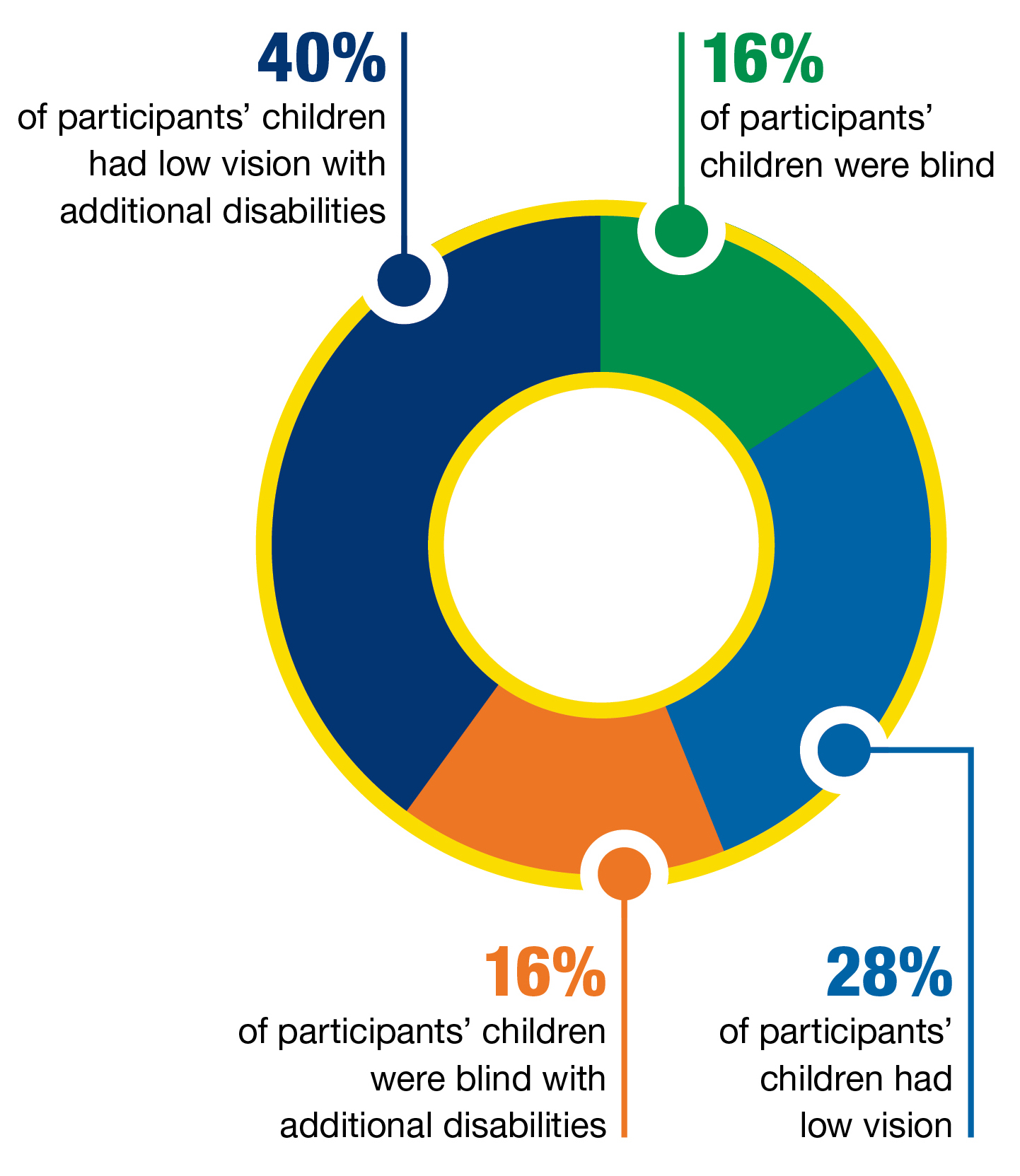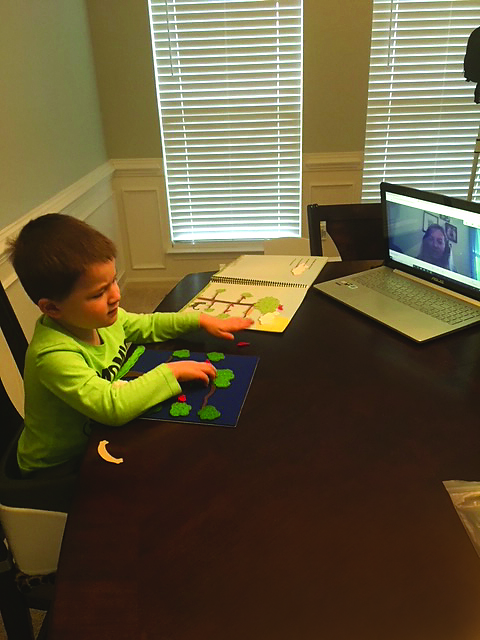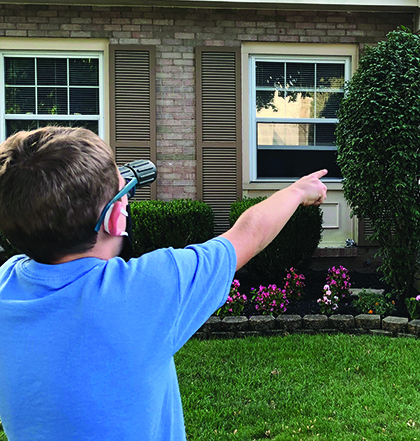The Access and Engagement survey investigated how the COVID-19 pandemic affected the education of students with visual impairments, including those with additional disabilities and deafblindness, and their family members in spring 2020. The study also examined the experiences of teachers of students with visual impairments (TVIs), orientation and mobility (O&M) specialists, and dually certified professionals during this time when education quickly shifted from in-person to remote instruction.
Participant Snapshot1
- All 50 U.S. states, the District of Columbia, and Puerto Rico were represented as well as six Canadian provinces
Circle chart: 455 Children Total; 73% of participants’ children were school-age2; 14% of participants’ children were in early intervention programs3; 13% of participants’ children were in preschool4
Circle chart: 455 Children Total; 40% of participants’ children had low vision with additional disabilities; 16% of participants’ children were blind; 16% of participants’ children were blind with additional disabilities; 28% of participants’ children had low vision
Children
Children in Early Intervention:
- Before COVID-19, 88% of children received early intervention services at home or in day care
- During COVID, 34% of family members were meeting online with professionals, 31% were receiving recommendations of online resources, and 24% were receiving emails with ideas
- Following a change in how early intervention was delivered, 46% of family members reported the same level of communication with educational team members and 27% reported increased communication
- 48% of family members experienced the same level of support and 26% experienced increased support from educational team members
Preschool Children:
- Prior to COVID-19, 33% of preschoolers attended a class with typically developing peers, 23% attended a special education preschool class, 18% attended a specialized school, and the rest attended preschool in other settings
- Most preschoolers who used a cane or tablet at school had access to those tools at home
- Not all families could be contacted once schools shifted to remote learning; of the professionals who established contact with families, 59% of preschool teachers, 69% of TVIs, and 60% of O&M specialists were working with preschoolers during the COVID-19 pandemic
- 40% of family members whose child was being educated during the COVID-19 pandemic were asked to show evidence their child had completed assignments
School-Age Children:
- 13% of students did not receive educational services during the COVID-19 pandemic, 61% attended school online, and 43% of students attending online had difficulty or were unable to access online programs because of their visual impairment
- Students had tools at school they did not have access to at home: 17% did not have tablets, 21% did not have laptops, 18% did not have Perkins braillers, 55% did not have large print books, 50% did not have screen reader software, and 28% did not have recreational braille books
- 75% of family members were concerned about their child’s progress after schools shifted to remote learning
Professionals
Circle chart: Professionals; 48% of professionals were employed by public schools; 17% of professionals were employed by specialized schools (on campus or in outreach); 19% of professionals were employed by other employers (e.g., self-employed, charter school); 16% of professionals were employed by cooperatives
Out of 1,028 professionals, 710 were TVIs, 138 were O&M specialists, and 180 were dually certified professionals
Professionals
- TVIs had an average of 10 direct service students, O&M specialists had an average of 15, and dually certified professionals had an average of 12
- 81% of professionals were given less than one week to prepare for the shift to online or remote education due to the COVID-19 pandemic
- 52% of professionals had at least one family they were not able to reach after the shift to remote learning
- 85% of TVIs who had students in a general or special education online class described having at least one student with an accessibility issue
- O&M specialists reported they were only working with 45% of their students in early intervention, preschool, and/or those with additional disabilities
- Although teaching remotely, O&M specialists were working with 95% of their students who had IEP goals for learning to travel on the school campus, in the neighborhood/residential area, in business/commercial environments, or using public transit, though activities they did with students had to be modified due to the shift caused by the COVID-19 pandemic
Our Recommendations
Promoting Success of Families and Professionals Working Together
- Educators must have time to communicate and plan with families
- Children’s educational teams must coordinate services and requests of families, including limiting the number of online sessions, documenting progress, and providing for services from braille transcribers, interveners, and other related service personnel so students have what they need to succeed
Policies and Practices that Promote Student Success
- As appropriate, extend early intervention eligibility for children beyond their third birthday, allow preschoolers an additional year of preschool services, and permit students graduating or aging out of special education who have not achieved their Individualized Education Program (IEP) goals to participate in extended school-year services or remain in school an additional year
- Provide professionals with support to find and implement service delivery models and tools to meet the unique needs of students, especially those with additional disabilities or deafblindness
- Establish policies that outline best practices for professionals to conduct evaluations and assessments5
Access to Mainstream and Assistive Technology Is Key
- Ensure learning platforms and tools are accessible and reliable for students, professionals, and family members
- Allocate time for professionals to teach families and students how to use both mainstream and assistive technology
- Provide accessibility training to general education and special education teachers
Delivering O&M Instruction During the Pandemic
- O&M specialists must provide clear and consistent modeling of O&M skills that are appropriate for the family to reinforce with the student
- Administrators should work closely with their legal department and O&M specialists to ensure there is a clear understanding of the O&M specialist’s liability coverage and what is permissible for the O&M specialist to do when not meeting in person with the student
- As soon as health department officials permit, O&M specialists must adapt hands-on instruction that meets social-distancing and safety guidelines
1. Please see the full report to assist in interpreting the percentages provided in this summary as the number of participants who answered any one question varied.
2. 54% of students were 5–12 years old and 46% were 13–21 years or older.
3. 61% of children receiving early intervention were between 2 and 3 years of age.
4. 15% of preschoolers were 3 years old, 47% were 4 years old, and 38% were 5–7 years old.
5. Dr. Yue-Ting Siu of San Francisco State University and colleagues have developed the document Comprehensive Evaluation of Blind and Low Vision Students During COVID-19: A Guidance Document that can serve as a blueprint. https://docs.google.com/document/u/1/d/1lZsOFKIJrLcHKRzVQVSkPRPII26iezV-fcfvQZQRlKc/copy







